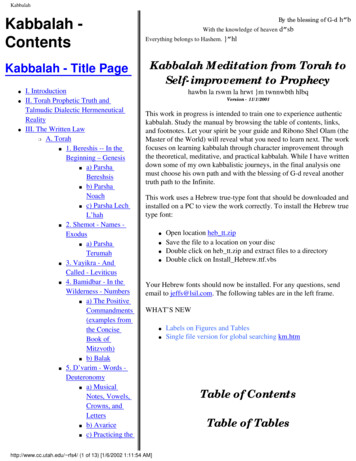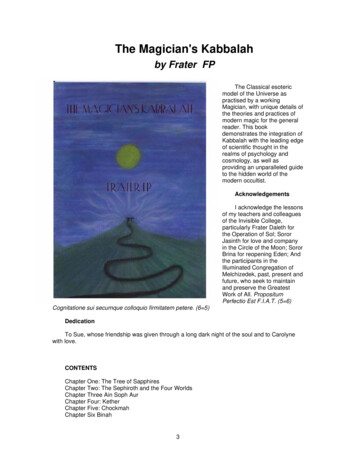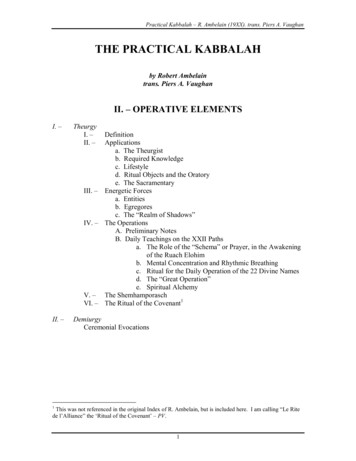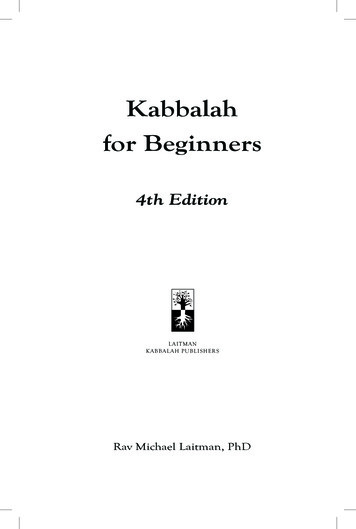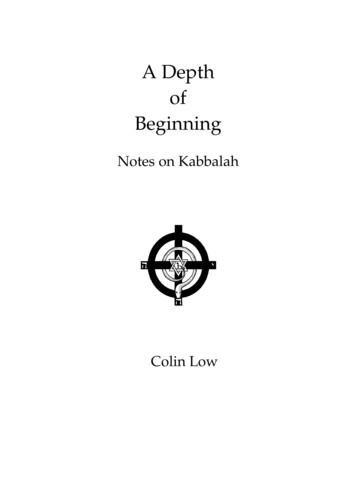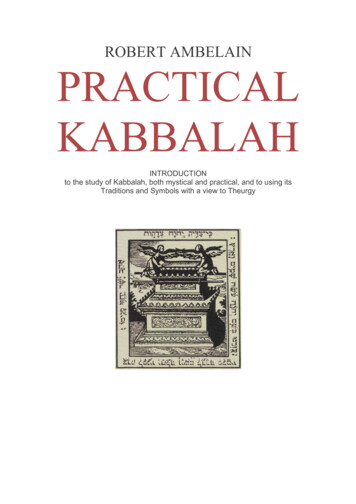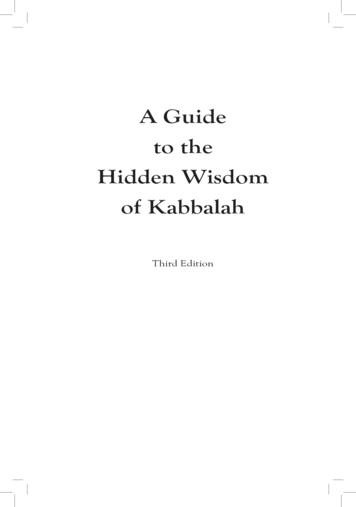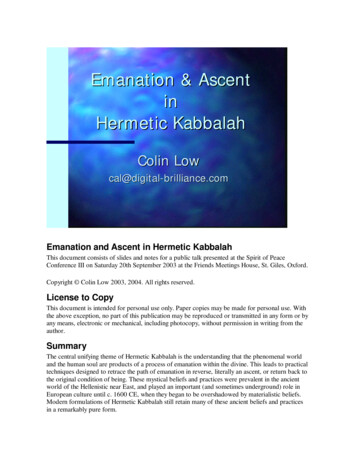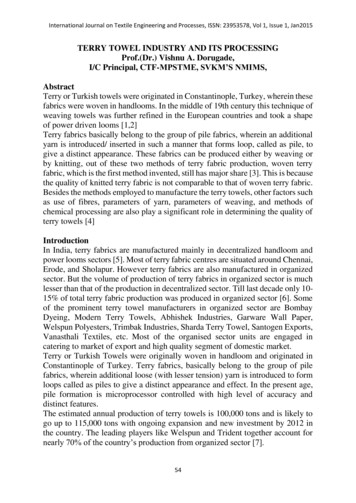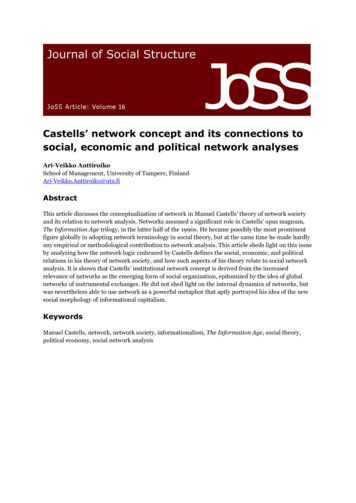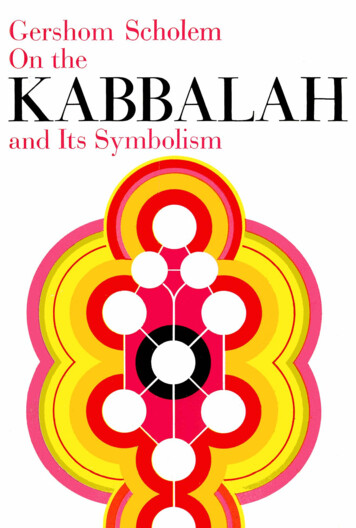
Transcription
ON THE KABBALAHAND ITS SYMBOLISM
ON THE KABBALAHAND ITS SYMBOLISMbyGERSHOM SCHOLEMtranslated byRALPH MANHEIMSchocken Books· New York
First SCHOCKEN PAPERBACK edition 19691085 86 87 88The translation of this volwne is basedupon the original edition published byRhein-Verlag, Zurich, under the titleZur Kabbala and ihrer Symbolik, copyright 1960 by Rhein-Verlag, Zurich. All rights reserved by Suhrkamp Verlag, Frankfurt am Main.English translation copyright 1965 by Schocken Books Inc.All rights reservedLibrary of Congress Catalog Card No. 65-11575Published by arrangement with Suhrkamp Verlag, Frankfurt am Main.Manufactured in the United States of AmericaISBN 0-8052-0235-8
ContentspageINTRODUCTIONII. R E L I G I O U S A U T H O R ITY AND MYS T I C I S M2. T H E M E A N I N G OF T H E T O R A H I NJ EW I S H32M YS T I C I S M3·K A B B A L A H A N D MYTH4·TRADITION ANDNEW87C REATION5.IN THET H E I D E A O F T H E G O L EMIIBqBINDEX205R ITUAL OF THE KABBALI STSv
ON THE KABBALAHAND ITS SYMBOLISM
IntroductionKabbalah, literally 'tradition,' that is, the tradition of thingsdivine, is the sum of Jewish mysticism. It has had a long historyand for centuries has exerted a profound influence on those amongthe Jewish people who were eager to gain a deeper understandingof the traditional forms and conceptions of Judaism. The literaryproduction of the Kabbalists, more intensive in certain periodsthan in others, has been stored up in an impressive number ofbooks, many of them dating back to the late Middle Ages. Formany centuries the chief literary work of this movement, theZohar, or 'Book of Splendor,' was widely revered as a sacred textof unquestionable value, and in certain Jewish communities itenjoys such esteem to this day. When Israel became an independ ent state, the Jews of Yemen, a remote and isolated principality insouthern Arabia, immigrated almost to a man aboard the 'magiccarpets,' as they called the airliners. They were obliged to abandonnearly all their belongings; but one object many had been un willing to part with was their copy of the Zohar, which they havecontinued to study to this day.But this world has been lost to European Jewry. Down to ourown generation, students of Jewish history showed little under standing for the documents of the Kabbalah and ignored themalmost completely. For in the late eighteenth century, when theJews of Western Europe turned so resolutely to European culture,one of the first and most important elements of their old heritageto be sacrificed was the Kabbalah. Jewish mysticism with its intri cate, introverted symbolism was felt to be alien and disturbing,and soon forgotten. The Kabbalists had attempted to penetrateand even to describe the mystery of the world as a reflection of theTHEI
INTRODUCTIONmysteries of divine life. The images into which their experiencehad crystallized were too deeply involved with the historical ex perience of the Jewish people, which in the nineteenth centuryseemed to have lost its relevance. For centuries the Kabbalah hadbeen vital to the Jews' understanding of themselves. Now itvanished beneath the turmoil of modern life, so completely thatfor whole generations next to nothing was known of it. Whatremained resembled an overgrown field of ruins, where only veryoccasionally a learned traveler was surprised or shocked by somebizarre image of the sacred, repellent to rational thought. The keyto the understanding of the Kabbalistic books seemed to havebeen lost. Scholars were perplexed and embarrassed by this world,which, instead of offering clear and simple concepts that could bedeveloped, presented symbols of a very special kind, in which thespiritual experience of the mystics was almost inextricably inter twined with the historical experience of the Jewish people.It is this interweaving of two realms, which in most other reli gious mysticisms have remained separate, that gave the Kabbalahits specific imprint. Small wonder that it seems strange to studentsof Christian mysticism, since it does not fit into the categories of'mysticism' with which they are familiar. The more sordid, pitiful,and cruel the fragment of historical reality allotted to the Jew amidthe storms of exile, the deeper and more precise the symbolicmeaning it assumed, and the more radiant became the Messianichope which burst through it and transfigured it. At the heart ofthis reality lay a great image of rebirth, the myth of exile and re demption, which assumed such vast dimensions with the Kab balists and accounts for their prolonged historical influence. For inthe books of the Kabbalists the personal element is almost negli gible and so veiled in all manner of disguises that we must lookvery closely to find it. Very rarely did a Kabbalist speak of his ownway to God. And the chief interest of the Kabbalah for us does notlie in such statements, but in the light it throws on the 'historicalpsychology' of the Jews. Here each individual was the totality.And this is the source of the fascination which the great symbolsof the Kabbalah possess for a historian no less than a psychologist.In the Kabbalah the law of the Torah became a symbol of cosmiclaw, and the history of the Jewish people a symbol of the cosmicprocess.In a generation that has witnessed a terrible crisis in Jewish his z
INTRODUCTIONtory, the ideas of these medieval Jewish esoterics no longer seemso strange. We see with other eyes, and the obscure symbols strikeus as worth clarifying. Research in this field involves an enormousresponsibility. In digging up and evaluating the material, a scholarmust make every effort to preserve a critical attitude. For longbefore historians became interested in Jewish mysticism, charla tans and cranks were drawn to it. This was of doubtful benefit tothe study of the Kabbalah. The endeavor to understand what washere enacted at the heart of Jewry cannot dispense with historicalcriticism and clear vision. For even symbols grow out of historicalexperience and are saturated with it. A proper understanding ofthem requires both a 'phenomenological' aptitude for seeingthings as a whole and a gift of historical analysis. One comple ments and clarifies the other; taken together, they promise valuablefindings.
I.Religious Authority and MysticismIproblem to be dealt with in the ensuing pages is of centralimportance to the history of religions and can be considered undera number of aspects. We shall start from the assumption that amystic, insofar as he participates actively in the religious life of acommunity, does not act in the void. It is sometimes said, to besure, that mystics, with their personal striving for transcendence,live outside of and above the historical level, that their experienceis unrelated to historical experience. Some admire this ahistoricalorientation, others condemn it as a fundamental weakness of mys ticism. Be that as it may, what is of interest to the history of reli gions is the mystic's impact on the historical world, his conRictwith the religious life of his day and with his community. No his torian can say-nor is it his business to answer such questions whether a given mystic in the course of his individual religiousexperience actually found what he was so eagerly looking for.What concerns us here is not the mystic's inner fulfillment. But ifwe wish to understand the specific tension that often prevailedbetween mysticism and religious authority, we shall do well torecall certain basic facts concerning mysticism.A mystic is a man who has been favored with an immediate, andto him real, experience of the divine, of ultimate reality, or who atleast strives to attain such experience. His experience may come tohim through sudden illumination, or it may be the result of longand often elaborate preparations. From a historical point of view,the mystical quest for the divine takes place almost exclusivelywithin a prescribed tradition-the exceptions seem to be limitedTHE
R E L I G I O U S A U T H O R ITY A N D MYS T I C I S Mto modern times, with their dissolution of all traditional ties.Where such a tradition prevails, a religious authority, establishedlong before the mystic was born, has been recognized by the com munity for many generations. Grounded in the specific experienceof the community, this authority has been developed through aninterchange between the community and those individuals whohave interpreted its fundamental experience and so helped thecommunity to express itself, who in a manner of speaking havemade it articulate. There is then a scale of values that has beentaken over from tradition; there is also a group of doctrines anddogmas, which are taken as authentic statements concerning thereligious experience of a given community. And there is in addi tion a body of rites and customs, traditionally believed to transmitthe values and express the mood and rhythm of religious life.Very different media can be invested with religious authority.They may be impersonal in character, a sacred book for example,or distinctly personal-in Catholicism, for example, it is the Popewho has the last word in deciding what is compatible with theCatholic tradition. There may also be mixtures and combinationsof the two types, or authority may reside in the consensus of anassembly of priests or other religious persons, even where-as inIslam-these representatives of authority need not actually meetin order to formulate or lend weight to their decisions.A mystic operates within the context of such traditional institu tions and authority. If he accepts the context and makes no attemptto change the community, if he has no interests in sharing hisnovel experience with others and finds his peace in solitary immer sion in the divine-then there is no problem, for there is nothingto bring him into conflict with others. There have assuredly beenobscure mystics of this kind in all religions. The Jewish mysticismof recent centuries, in any case, has brought forth the 'hiddensaint' (nistar), an enormously impressive type with a profoundappeal for the common people. According to a tradition that goesback to Talmudic times there are, in every generation, thirty-sixrighteous men who are the foundations of the world. If the anony mity, which is part of their very nature, were broken, they wouldbe nothing. One of them is perhaps the Messiah, and he remainshidden only because the age is not worthy of him. Especiallyamong the Hasidim of Eastern Europe, later generations spunendless legends about these most obscure of men, whose acts,6
R E L I GI O U S A U T H O R I T Y A N D M Y S T I C I S Mbecause they are performed so entirely beyond the ken of the com munity, are free from the ambiguities inseparable from all publicaction. In a truly sublime sense the 'hidden saint' makes religiona private affair, and because he is by definition barred from com munication with other men, he is unaffected by the problemsinvolved in all dealings with society.But let us make no mistake. Inestimable as may be the worth ofthese mute, anonymous saints, the history of religions is not con cerned with them. It is concerned with what happens when menattempt to enter into communication with each other. And itis generally recognized that in the case of mystics such communi cation presents a problem. From a historian's point of view, thesum of religious phenomena known as mysticism consists in theattempts of mystics to communicate their 'ways,' their illumina tions, their experience, to others. If not for such attempts it wouldbe impossible to regard mysticism as a historical phenomenon. Andit is precisely in the course of such attempts that mysticism comesto grips with religious authority.All mysticism has two contradictory or complementary aspects:the one conservative, the other revolutionary. What does thismean?It has been said that mystics are always striving to put new wineinto old bottles-just what a famous passage in the Gospelswarns us not to do. It seems to me that this formulation is strik ingly apt and of the utmost relevance to our problem. How can amystic be a conservative, a champion and interpreter of religiousauthority? How is he able to do what the great mystics of Catho licism, such Sufis as Ghazzali, and most of the Jewish Kabbalistsdid? The answer is that these mystics seem to rediscover thesources of traditional authority. Perceiving the ancient founda tions of this authority, they have no desire to change it. On thecontrary, they try to preserve it in its strictest sense.Sometimes this conservative function has been included in thevery definition of mysticism-but this strikes me as questionableand one-sided. An American author, for example, has defined mys ticism as 'the endeavor to secure consciousness of the presence ofthe Agency through which (or through Whom) the conservationof socially recognized values is sought.'1The conservative function of mysticism is made possible by the1 K. Wright,A Student's Philosophy of Religion, New York, 1 938,7p.287.
R E L I G I O U S A U T H O R I TY A N D M Y S T I C I S Mfact that the fundamental mystical experience has two aspects. Initself it has no adequate expression; mystical experience is funda mentally amorphous. The more intensely and profoundly the con tact with God is experienced, the less susceptible it is of objectivedefinition, for by its very nature it transcends the categories ofsubject and object which every definition presupposes. On theother hand, such experience can be interpreted in different ways,that is, clothed in different meanings. The moment a mystic triesto clarify his experience by reflection, to formulate it, and es pecially when he attempts to communicate it to others, he cannothelp imposing a framework of conventional symbols and ideasupon it. To be sure, there is always some part of it that he cannotadequately and fully express. But if he does try to communicatehis experience-and it is only by doing so that he m
THE Kabbalah, literally 'tradition,' that is, the tradition of things divine, is the sum of Jewish mysticism. It has had a long history and for centuries has exerted a profound influence on those among the Jewish people who were eager to gain a deeper understanding of the traditional forms and conceptions of Judaism. The literary production of the Kabbalists, more intensive in certain periods .
